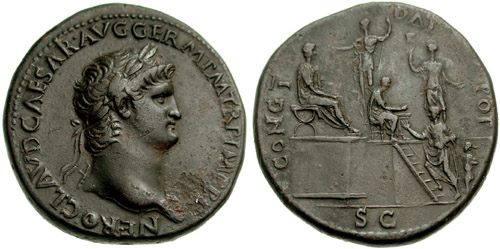
Classical Numismatic Group, Inc. >Auction >Triton VII (12.01.2004)
 |
| 写真提供:Classical Numismatic Group, Inc. |
 超拡大ボタン 超拡大ボタン |
| |
|
|
|
Classical Numismatic Group, Inc. >Auction>Triton VII (12.01.2004)
Lot :873
Price :4750 USD
Description
Estimate $3000
NERO. 54-68 AD. Sestertius (26.13 gm). Rome mint. Struck circa 64 AD. NERO CLAVD CAESAR AVG GERM P M TR P IMP P P, laureate and bearded head right, aegis at point of bust / CONG I DAT POP, S C in exergue, Nero seated right in curule chair on raised da?s; official seated right, before, drawing tessera from container and handing it to figure climbing ladder left and extending hand to receive it; child standing behind; statue of Minerva standing left on pedestal, holding owl and sceptre and Liberalitas standing facing, holding abacus and extending hand, on da?s behind. RIC I 153; WCN 98; CNR XVIII, 787 = Mazzini 69 (same obverse die); BMCRE 136 var. (obverse legend); BN 275; Cohen 69. Good VF, nice even, brown patina, very minor roughness at point of bust. ($3000)
Ex Sternberg XVI (15-16 November 1985), lot 261, where it realized SF 6200.
Scenes in which the emperor makes public distributions to citizens, a ceremony known as a congiarium, first appear on coinage at this time. Since the donativum, in which gifts were made to the army, become popular later, in the mid-2nd century the donation scenes are usually identified as Liberalitas types rather than congiarium types.
The precise reason (or reasons) for the congiarium commemorated on these two sestertii is unknown. Confusion arises from their numbering, I and II, while both share similar types, mint, and date of striking. As a result, Mattingly suggested the distinctions CONG I and CONG II may indicate that one donation was of money, and the other of grain. This particular variant of Nero’s congiarium scene served as a model for sestertii of Nerva nearly a half century later.
"
show10goo 無断転用を禁止します。
| 
